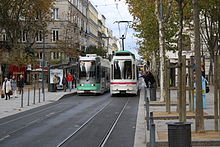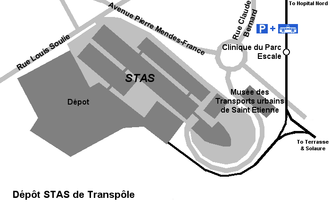Société de Transports de l'Agglomération Stéphanoise
| Société de Transports de l'Agglomération Stéphanoise | |
|---|---|

|
|
| Basic information | |
| Company headquarters | St-Priest-en-Jarez Cedex |
| Web presence | STAS homepage |
| Reference year | 2011 |
| owner | Transdev |
| Employee | 681 |
| Lines | |
| Gauge | 1000 mm ( meter gauge ) |
| tram | 3 |
| trolleybus | 1 |
| bus | 69 |
| number of vehicles | |
| Tram cars | 47 |
| Omnibuses | 305 |
| statistics | |
| Passengers | 200,000 a day |
| Mileage | 10 247 450 km |
| Residents in the catchment area |
391.4 thousand |
| Length of line network | |
| Tram lines | 23.3 |
| Operating facilities | |
| Depots | 4th |
The Société de Transports de l'Agglomération Stéphanoise , STAS for short , is a local transport company in the French city of Saint-Étienne . It belongs to Transdev , which operates the traffic on behalf of and for the account of the Saint Étienne Métropole association. It is an amalgamation of 53 municipalities - 45 of them are connected to the STAS local transport network. The STAS network comprises the three lines of the Saint-Étienne tram , a trolleybus line in Saint-Étienne and the bus service in Saint-Étienne-Métropole .
history
The city of Saint-Étienne - along with Lille and Marseille - is one of the three cities in France where trams survived the wave of decommissioning of the post-war period. The beginnings of the tram go back to the year 1881, when the first meter-gauge steam tram was opened by the Compagnie des chemins de fer à voie étroite de Saint-Étienne, Firminy, Rive-de-Gier et extentions , or CFVE for short . From 1901, the Chemins de fer départementaux de la Loire , or CFDL for short , were added. The latter were shut down again in the 1930s due to high operating losses.
However, the trams had been running electrically since 1897, when the Électriques de Saint-Étienne tramway started operating. By 1914, the CFVE network was also electrified. In 1932 the two companies merged. In the following years, the omnibus emerged as a competitor and the first tram lines had to be discontinued.
During the Second World War , the city decided to abolish the tram and replace it with trolleybuses. The first line was switched to trolleybus operation on January 1, 1942. Until 1952, only line 4 was left. Ultimately, it is only thanks to the tram passengers that this important but outdated line was saved. After lengthy persuasion work by a passenger association that had to contend with resistance from the press, politics and the car lobby, it finally succeeded in getting new cars through. In 1958, new vehicles of the PCC type based on the Brussels model were purchased.
The new wagons were followed by a complete modernization of the route. They created their own routes and redesigned the stops. In 1980 the CFCE was merged into the newly founded STAS . Soon afterwards the tariff system was redesigned and on November 1, 1982 one-man operation was started. On February 17, 1998, with the extension of the line by 1.5 kilometers south, the first new line in France after the end of the Second World War was inaugurated.
The STAS transport network
A total of three tram lines, one trolleybus line and 57 bus lines (some by subcontractors) are operated.
The two zones
The network is divided into the two zones Grand Saint-Etienne (with three tram lines, one trolleybus line and 43 bus routes) and Grand Gier (six bus routes and four school bus routes ). The two zones are linked by local trains and two bus routes. A special network pass called Oùra allows the use of all local trains between the ten train stations in its area of validity and the other lines of public transport.
tram
trolleybus
Along with Limoges , Lyon and Nancy, Saint-Étienne is one of four French cities in which trolleybuses operate. The trolleybus network consisted of seven lines until the 1990s. However, only one line remained until 2011, all others were switched to diesel operation:
- Line 3 Cotonne ↔ Terrenoire
On July 17, 2018, an order for 22 so-called "hybrid trolleybuses" for delivery from 2019 was put out to tender. The twelve-meter-long vehicles are to take over several lines currently operated by diesel buses apart from the catenary network in battery operation. The batteries are to be charged from the overhead contact line while the vehicle is in motion - also from existing overhead contact line sections of disused lines. In addition, the reactivation of the disused trolleybus line 7 from Michon to Bellevue , whose contact lines were not dismantled, is planned.
Depots and transport museum
STAS has four depots:
- Transpôle depot in Saint-Priest-en-Jarez on Rue Pierre Mendès France. This is where the STAS headquarters are located. This depot is home to buses and trams on 9 hectares. It is located near the Clinique du Parc tram stop on T1.
- Transparc depot in Saint-Etienne on rue Pierre Copel. This is where all the trolleybuses and most of the buses that run in the city center of Saint-Étienne are located on an area of 2 hectares.
- Pont Chaney depot in Firminy on Rue Victor Hugo. This depot has an area of 3300 m² and is responsible for the bus routes that leave Firminy.
- Depot in Saint-Chamond . This is where the buses of the lines in the greater Grand Gier area are located.
There is also a small transport museum at the Transpôle depot ( Musée des transports urbains de Saint-Étienne et sa région ). You can see a steam tram and electric railcars of the series "H" from 1907, "J" from 1938 and a "PCC" from 1958. There is also a trolleybus and various omnibuses (VETRA built in 1952 and SAVIEM Year of construction 1966).
Web links
Individual evidence
- ↑ Blickpunkt Tram 5/2018, p. 124.







